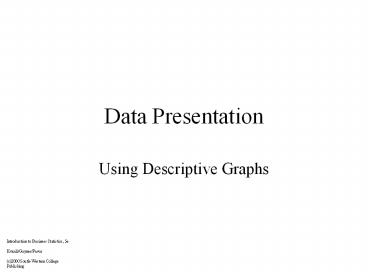Data Presentation PowerPoint PPT Presentation
Title: Data Presentation
1
Data Presentation
- Using Descriptive Graphs
Introduction to Business Statistics, 5e
Kvanli/Guynes/Pavur (c)2000 South-Western
College Publishing
2
Constructing a Frequency Distribution
- 1. Gather the data.
- 2. Arrange the data in an ordered array.
- 3. Select the number of classes.
- 4. Determine the class width.
- 5. Determine the class limits for each class.
- 6. Count the number of data items in each class.
- 7. Summarize into a frequency distribution table.
Introduction to Business Statistics, 5e
Kvanli/Guynes/Pavur (c)2000 South-Western
College Publishing
3
Frequency Distribution
- Number of Classes (K) value chosen to best
represent the data - Class Width (CW)
Introduction to Business Statistics, 5e
Kvanli/Guynes/Pavur (c)2000 South-Western
College Publishing
4
Frequency Distribution for Continuous Data
Introduction to Business Statistics, 5e
Kvanli/Guynes/Pavur (c)2000 South-Western
College Publishing
5
Frequency Distribution for Continuous Data
Introduction to Business Statistics, 5e
Kvanli/Guynes/Pavur (c)2000 South-Western
College Publishing
6
Frequency Distribution for Discrete Data
Introduction to Business Statistics, 5e
Kvanli/Guynes/Pavur (c)2000 South-Western
College Publishing
7
Histogram
- A Histogram is a graphical representation of a
frequency distribution for continuous data. - The height is proportional to the frequency of
that class
Introduction to Business Statistics, 5e
Kvanli/Guynes/Pavur (c)2000 South-Western
College Publishing
8
Introduction to Business Statistics, 5e
Kvanli/Guynes/Pavur (c)2000 South-Western
College Publishing
9
Introduction to Business Statistics, 5e
Kvanli/Guynes/Pavur (c)2000 South-Western
College Publishing
10
Stem-and-Leaf Diagrams
- Stem-and-Leaf Diagrams were developed to
summarize data without loss of information.
Introduction to Business Statistics, 5e
Kvanli/Guynes/Pavur (c)2000 South-Western
College Publishing
11
Stem-and-Leaf DiagramsIllustration
Reports of the after-tax profits of 12 companies
are (recorded as cents per dollar of revenue)
as follows 3.4, 4.5, 2.3, 2.7, 3.8, 5.9, 3.4,
4.7, 2.4, 4.1, 3.6, 5.1
Stem Leaf (unit .1)
2 3 4 5
3 4 7 4 4 6 8 1 5 7 1 9
Introduction to Business Statistics, 5e
Kvanli/Guynes/Pavur (c)2000 South-Western
College Publishing
12
Stem-and-Leaf
By rotating the Stem-and-Leaf we get an image
of the shape of the data.
3 4 7 4 4 6 8 1 5 7 1 9
Stem Leaf (unit .1)
2 3 4 5
Introduction to Business Statistics, 5e
Kvanli/Guynes/Pavur (c)2000 South-Western
College Publishing
13
Figure 2.9
Introduction to Business Statistics, 5e
Kvanli/Guynes/Pavur (c)2000 South-Western
College Publishing
14
Frequency Polygon
- A frequency polygon is a graph that represents
the shape of the data. It can be conceptualized
as a connection of the midpoints of the classes
at the height specified by the frequency.
Introduction to Business Statistics, 5e
Kvanli/Guynes/Pavur (c)2000 South-Western
College Publishing
15
Relative Frequency Polygon
- A relative frequency polygon is similar to a
frequency polygon, except that the height is
dictated by the relative frequency
Introduction to Business Statistics, 5e
Kvanli/Guynes/Pavur (c)2000 South-Western
College Publishing
16
Figure 2.17
Introduction to Business Statistics, 5e
Kvanli/Guynes/Pavur (c)2000 South-Western
College Publishing
17
Cumulative Frequencies
- A Cumulative Frequency table provides
information on the number of values that are less
than the upper class limit.
Introduction to Business Statistics, 5e
Kvanli/Guynes/Pavur (c)2000 South-Western
College Publishing
18
Introduction to Business Statistics, 5e
Kvanli/Guynes/Pavur (c)2000 South-Western
College Publishing
19
Bar Charts
- Bar Charts are used for graphical representation
of Nominal and Ordinal data. - As with a Histogram the height of the bar is
proportional to the number of values in the
category.
Introduction to Business Statistics, 5e
Kvanli/Guynes/Pavur (c)2000 South-Western
College Publishing
20
Figure 2.20
Introduction to Business Statistics, 5e
Kvanli/Guynes/Pavur (c)2000 South-Western
College Publishing
21
Pie Chart
- The Pie Chart is an alternative to the Bar Chart
for Nominal and Ordinal data. - The proportion of the Pie represents the
categorys percentage in the population or sample.
Introduction to Business Statistics, 5e
Kvanli/Guynes/Pavur (c)2000 South-Western
College Publishing
22
Figure 2.23
23
Deceptive Graphs
- If care is not taken in constructing graphs, the
graph may not properly present the data. - Also, Graphs can be purposely manipulated to
provide false impressions of the data.
Introduction to Business Statistics, 5e
Kvanli/Guynes/Pavur (c)2000 South-Western
College Publishing
24
Common Deceptive GraphsFigure 2.26
Introduction to Business Statistics, 5e
Kvanli/Guynes/Pavur (c)2000 South-Western
College Publishing
25
Common Deceptive Graphs Figure 2.27
Introduction to Business Statistics, 5e
Kvanli/Guynes/Pavur (c)2000 South-Western
College Publishing
26
Common Deceptive Graphs Figure 2.28
Introduction to Business Statistics, 5e
Kvanli/Guynes/Pavur (c)2000 South-Western
College Publishing

